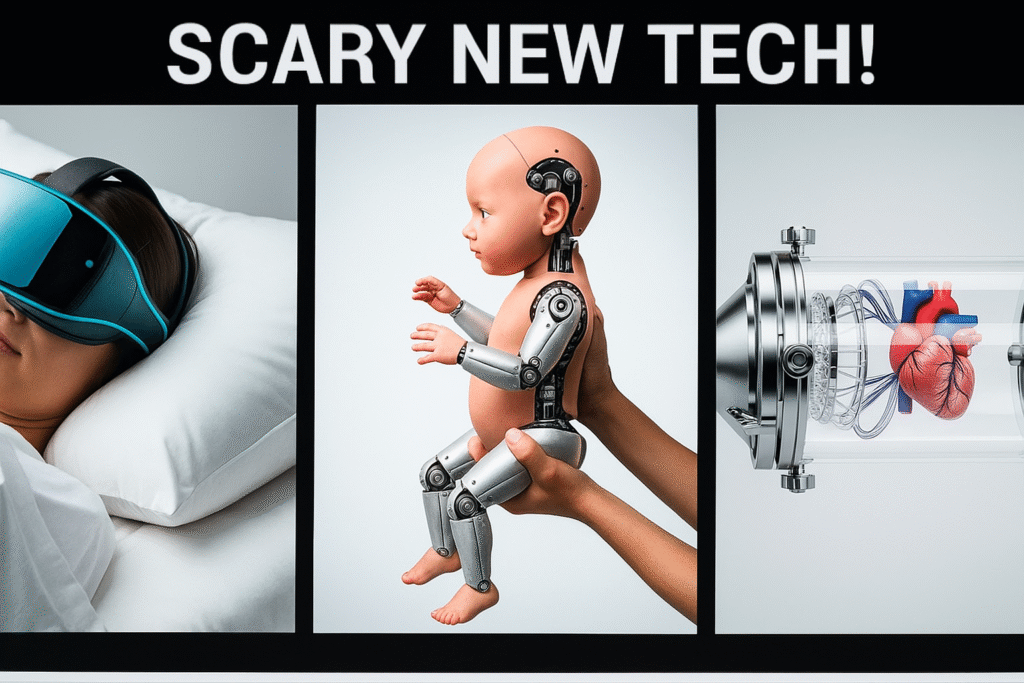Introduction to Bizarre Tech Trends

Technology is evolving at a pace faster than society can adapt. From machines reading our dreams to algorithms deciding justice, the world is heading toward an era where the line between science fiction and reality is razor-thin. In this article, we’ll explore 15 bizarre tech trends reshaping our future in unsettling yet fascinating ways.
1. Lucid Dream Communication
In 2021, researchers achieved two-way communication with people during lucid dreaming. Dreamers solved math problems and answered questions using eye movements and muscle signals. While not true telepathy, this breakthrough shows how sleep might no longer be a private sanctuary.
2. Brain-to-Brain Communication
Imagine collaborating without words. Experiments like Brainet have proven that signals can travel directly between human brains via EEG and transcranial magnetic stimulation. While bandwidth is limited today, it suggests a future where even thoughts may not remain private.
3. Digital Resurrection Technology
“Griefbots” are chatbots trained on a deceased person’s data—posts, messages, and voice recordings—to mimic their personality. Companies like Hereafter AI are already providing digital legacies, raising questions about identity, memory, and morality in the age of AI.
4. Emotion-Sensing AI
Startups like Hume AI are creating systems that detect emotion through speech, facial micro-expressions, or biometrics. While potentially useful in therapy or customer service, regulators warn of risks, especially when used in workplaces and schools.
5. AI-Powered Mind Control
Neurostimulation devices already help Parkinson’s patients and treat severe depression. With AI, these implants can now adapt in real time. But the same technology reveals a darker truth—machines can not only read brain activity but also alter it.
6. Real-Time Thought Reading
Brain-computer interfaces (BCIs) are decoding thoughts into speech, giving paralyzed patients a new voice. In China, national initiatives are pushing toward commercial BCI devices by 2030. This raises both hope and fears about privacy of thought.
7. AI-Generated Hyperpersonalized Media
Streaming platforms are testing films and shows generated uniquely for each viewer. Imagine a movie that no one else on Earth will ever see. While exciting, this kind of personalization could isolate audiences instead of bringing them together.
8. Emotional Support Robots
From robotic pets for the elderly to AI-powered companions for children, emotional support robots are on the rise. While they may ease loneliness, critics argue they exploit human psychology by replacing authentic relationships with machine simulations.
9. Autonomous Urban Robots
Delivery robots, robotic police assistants, and AI-driven public machines are becoming common. Cities are struggling to regulate their presence, raising debates about safety, liability, and constant surveillance in urban life.
10. AI-Driven Smart Cities
Singapore and Dubai are already testing AI-managed city infrastructure. Smart traffic systems, energy grids, and surveillance networks promise efficiency but risk turning cities into controlled surveillance hubs.
11. Editable Humans (Gene Editing)
CRISPR technology is advancing quickly, with trials correcting genetic diseases. But controversy arose when twin girls were born with edited embryos in 2018. The dilemma remains: should we cure illnesses or redesign humanity?
12. Mind-Machine Merging
Neuralink and competitors are developing brain implants that let humans control devices with thought. While promising for people with paralysis, the idea of merging human intent with machine action remains unsettling.
13. Deepfake Technology
AI-generated deepfakes can now replicate both faces and voices with frightening accuracy. Regulators are scrambling to implement safeguards, but the spread of misinformation, fraud, and political manipulation is already rampant.
14. Swarming Killer Drones
Autonomous drone swarms are being tested by militaries worldwide. These machines can share data and make strike decisions without human oversight. While efficient in warfare, the ethical risks are enormous.
15. AI Judges and Automated Justice Systems
China and Estonia are experimenting with AI-driven justice. While AI may improve efficiency in courts, bias, accountability, and moral judgment remain unresolved. Machines deciding human fates could fundamentally alter society’s trust in justice.
FAQs About Bizarre Tech Trends
1. What are bizarre tech trends?
Bizarre tech trends are emerging technologies that seem unsettling or futuristic but are already becoming reality.
2. Can lucid dream communication really work?
Yes. Studies show real-time communication with dreamers is possible using eye and muscle signals.
3. Are AI judges being used today?
Yes. Estonia and China are testing AI in courts, mainly for small civil claims.
4. Is brain-to-brain communication possible?
Yes, though still experimental, scientists have transmitted yes/no signals directly between human brains.
5. Are emotional support robots ethical?
Opinions differ—some see them as beneficial for mental health, while others worry about replacing human interaction.
6. What’s the biggest risk of these tech trends?
The main risks include loss of privacy, misuse in warfare, and ethical dilemmas about identity, control, and justice.
Conclusion
The bizarre tech trends of 2025 blur the lines between science fiction and reality. From dream communication to AI judges, these innovations challenge our understanding of privacy, morality, and humanity itself. While some breakthroughs promise healing and convenience, others raise unsettling questions about control, freedom, and trust in the digital age.
World Economic Forum on Emerging Tech


